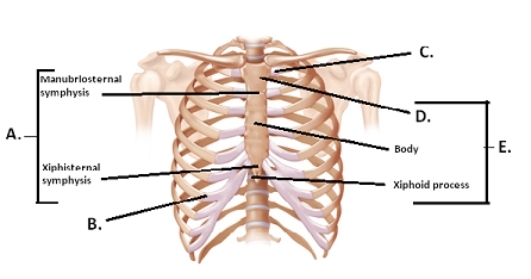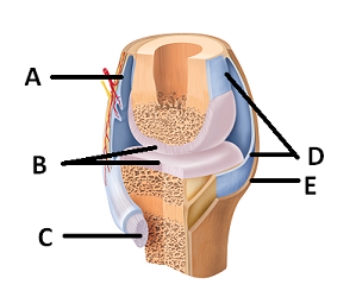A) dorsiflexion
B) plantar flexion
C) inversion
D) eversion
E) circumduction
Correct Answer

verified
Correct Answer
verified
Multiple Choice
 -The figure illustrates the joints and bones of the rib cage.What does "D" represent?
-The figure illustrates the joints and bones of the rib cage.What does "D" represent?
A) costochondral joint
B) sternum
C) manubrium
D) sternal symphyses
E) sternocostal synchrondrosis
Correct Answer

verified
Correct Answer
verified
Multiple Choice
Harry is told he has structural damage to his dentoalveolar joint.Where specifically is the problem area?
A) Between his sacrum and coxa.
B) At his symphysis pubis.
C) In his cervical region between the atlas and axis.
D) Between his tooth socket and tooth.
E) At the suture between the two parietal bones.
Correct Answer

verified
Correct Answer
verified
Multiple Choice
This type of joint is multiaxial allowing a wide range of movement.
A) saddle
B) hinge
C) pivot
D) plane
E) ball and socket
Correct Answer

verified
Correct Answer
verified
Multiple Choice
Synovial joints are different from both fibrous and cartilaginous joints because synovial joints
A) use fibrous connective tissue to hold the bones in the joint together.
B) are enclosed by a joint capsule.
C) are only temporary; they are replaced in the adult.
D) generally have both bones in the joint fused together.
E) are not freely moveable.
Correct Answer

verified
Correct Answer
verified
Multiple Choice
Raul's father tells him not to slouch,and to put his shoulders back.What specifically must Raul do to improve his posture?
A) laterally rotate his humerus
B) medially rotate his humerus
C) depress his scapulae
D) retract his scapulae
Correct Answer

verified
Correct Answer
verified
Multiple Choice
Which of the following joints is most movable?
A) suture
B) syndesmosis
C) symphysis
D) synovial
E) synchondrosis
Correct Answer

verified
Correct Answer
verified
Multiple Choice
LaTonya gets her hand caught in the car door at her knuckles.Which of these specific joints is injured?
A) radiocarpal joints
B) metacarpophalangeal joints
C) atlantoaxis joints
D) metatarsophalangeal joints
E) interphalangeal joints
Correct Answer

verified
Correct Answer
verified
Multiple Choice
A joint that consists of two opposed flat surfaces of approximately equal size is a _____ joint.
A) plane
B) saddle
C) hinge
D) pivot
E) ellipsoid
Correct Answer

verified
Correct Answer
verified
Multiple Choice
Lyme disease is
A) a bacterial infection transmitted by ticks.
B) an inflammation of any joint.
C) a metabolic disorder caused by increased uric acid in blood.
D) a condition that may involve an autoimmune disease.
E) the most common type of arthritis.
Correct Answer

verified
Correct Answer
verified
Multiple Choice
 -What does structure "B" represent on the diagram?
-What does structure "B" represent on the diagram?
A) tendon
B) articular cartilage
C) bursa
D) fibrous capsule
E) synovial membrane
Correct Answer

verified
Correct Answer
verified
Multiple Choice
Which of the following joints is most movable?
A) plane
B) saddle
C) hinge
D) pivot
E) ball and socket
Correct Answer

verified
Correct Answer
verified
Multiple Choice
The cubital or elbow joint is an example of a _____ joint.
A) saddle
B) hinge
C) pivot
D) ball and socket
E) plane
Correct Answer

verified
Correct Answer
verified
Multiple Choice
Which of the following statements concerning bursae is true?
A) They are filled with air.
B) They are a cellular cushion.
C) They carry blood vessels to joints.
D) They are formed by an extension of the synovial membrane.
E) They bind tendons to ligaments.
Correct Answer

verified
Correct Answer
verified
Multiple Choice
The sagittal suture is between the
A) sacrum and coxa.
B) two pubic bones.
C) atlas and axis.
D) alveolar process and tooth.
E) two parietal bones.
Correct Answer

verified
Correct Answer
verified
Multiple Choice
The joint between the teeth and the mandibular alveolus is an example of a
A) suture.
B) syndesmosis.
C) gomphosis.
D) synostosis.
E) symphysis.
Correct Answer

verified
Correct Answer
verified
Multiple Choice
In the TMJ joint,the mandible articulates with the
A) temporal bone.
B) maxilla.
C) zygomatic bone.
D) tympanic bone.
E) parietal bone.
Correct Answer

verified
Correct Answer
verified
Multiple Choice
The epiphyseal plate of a growing bone is actually a temporary joint called a
A) synchondrosis.
B) synostosis.
C) syndesmosis.
D) symphysis.
E) suture.
Correct Answer

verified
Correct Answer
verified
Multiple Choice
Most of the joints in the appendicular skeleton are _____ joints.
A) fibrous
B) immovable
C) synovial
D) cartilaginous
E) inarticulate
Correct Answer

verified
Correct Answer
verified
Multiple Choice
The three arches of the foot
A) transfer weight from the tibia to the femur.
B) distribute the weight of the body during standing and walking.
C) form a hinge joint.
D) are highest on the lateral side of the foot.
E) form after birth.
Correct Answer

verified
Correct Answer
verified
Showing 41 - 60 of 119
Related Exams